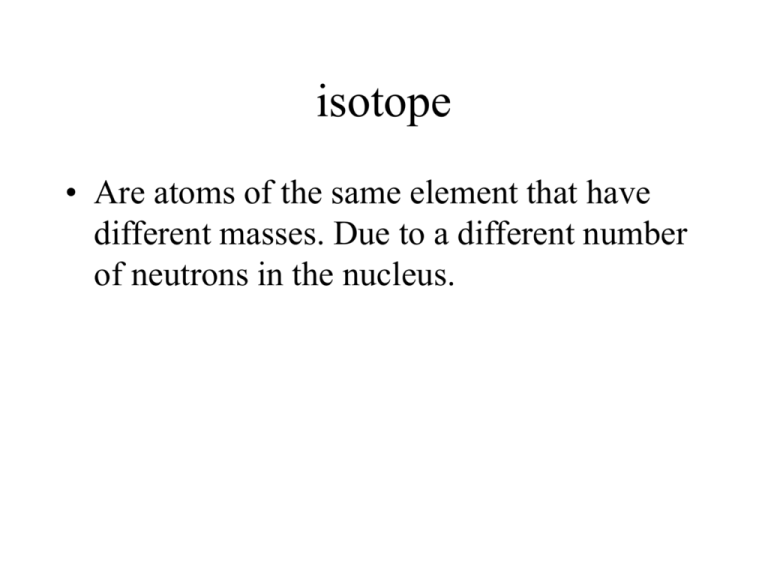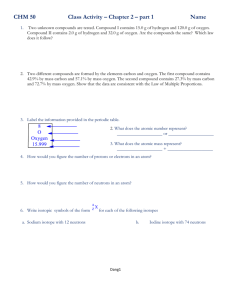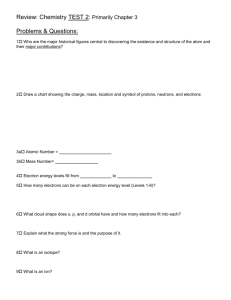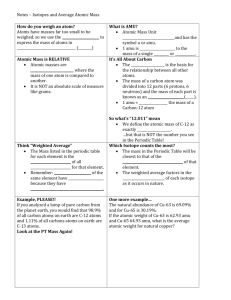isotope
advertisement

isotope • Are atoms of the same element that have different masses. Due to a different number of neutrons in the nucleus. Nuclide • Is a general term for any isotope of any element. Atomic number • Represented in mathematical equations by the letter Z in the book examples. • Remember. The number of protons is represented by the atomic number, and will never change. It is the “fingerprint” of the element. Mass number • Is the total number of protons and neutrons in the nucleus of an isotope. • The neutron and the proton mass values are each approx 1. • The periodic table reports the average atomic mass of the many nuclides of a particular atom Atomic mass unit • The mass of atoms is extremely small. • Therefore, we use relative atomic masses because it is easier to do calculations. • Arbitrarily chose a standard and assigned a relative mass value. • Selected the carbon –12 nuclide. Atomic mass unit or amu • Carbon -12 has been assigned the relative value of 12 amu. • Or 1 amu is exactly 1/12th the mass of a carbon-12 atom ( nuclide) • Mass of any nuclide is compared to the carbon –12 nuclide • An atom that is 4x the mass of the carbon12 atom will be 4 x 12 amu = 48 amu. continued • An atom that is 2/3 the mass of the carbon12 atom will have a mass of 2/3 x 12 amu = 8 amu. Finding average atomic mass • Multiply the abundance factor, (%), by the mass number of the isotope • Add up all the isotopes • Divide by 100 example • Neon has two isotopes Ne-20 has a mass of 19.992 amu and occurs in nature 90% of the time. Ne-22 has a mass number of 21.991 amu and occurs 10% of the time. • ((90 x 19.992) + (10 X 21.991) ) / 100 = 20.192 amu How many in a dozen? • How many in 2 dozen • If you have 36 shoes, how many dozen? Mole • The chemist dozen • Instead of 12 units of something it is 6.02 x10 23 units of something. • 6.02 x 1023 is called Avogadro’s number – Or the number of particles in exactly one mole of a substance. Molar mass • The mass of one mole of a substance. • Units are g/mol • Numerically equal to the atomic mass listed on the periodic table. • The molar mass of an element contains one mole, or 6.02 x1023 atoms of that element. conversions • He has a molar mass of 4.00 g/mol • How many grams of He are there in 5 moles? • 4.00 g/mol x 5 mol = 20 grams • Note: the mole unit crosses out. problem • How many grams will there be in 4 moles of oxygen? again • How many grams are there in 4.5 moles of copper? • Page 83 sample problem 3-2 1,2,3,4 Now the other way • Given the grams calculate the moles. • You have 72 grams of copper, how many moles do you have? • 72 grams / 63.55 g/mol = 1.13 moles of Cu • Page 83 sample problem 3-3 1,2 How many moles is a given # of atoms? • If you have 2.0 x 10 23 atoms of Ca, how many moles do you have. • 2.0 x 1023 atom Ca x 1 mol Ca/6.02x 1023 atom of Ca = 0.33 mol Ca • Page 84 sample problem 3-4 1,2,3 Given # atoms find the mass • Find the mass of 5 x 10 16 atoms of copper. • 5 x 10 16 atoms Cu x 1mole/6.02x10 23atoms multiplied by 63.55 g/mol = 1.31 x 10-9 • Page 85 practice problem 3-5 1,2,3







